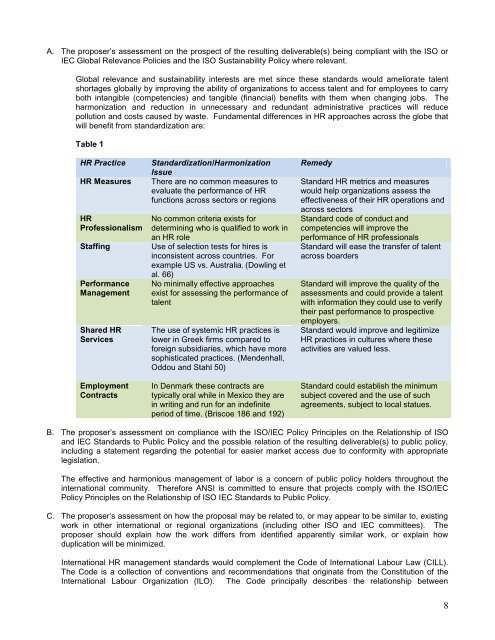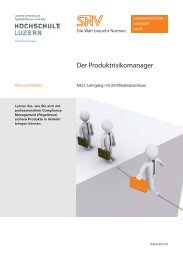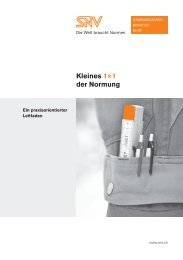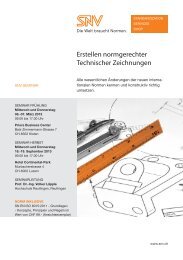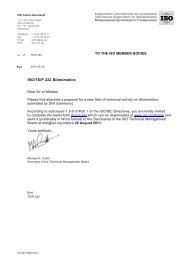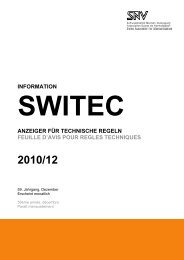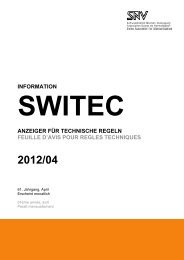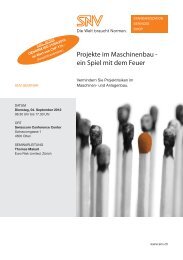A. The proposer‟s assessment on the prospect of the resulting deliverable(s) being compliant with the <strong>ISO</strong> orIEC Global Relevance Policies and the <strong>ISO</strong> Sustainability Policy where relevant.Global relevance and sustainability interests are met since these standards would ameliorate talentshortages globally by improving the ability of organizations to access talent and for employees to carryboth intangible (competencies) and tangible (financial) benefits with them when changing jobs. Theharmonization and reduction in unnecessary and redundant administrative practices will reducepollution and costs caused by waste. Fundamental differences in HR approaches across the globe thatwill benefit from standardization are:Table 1HR PracticeHR MeasuresHRProfessionalismStaffingPerformanceManagementShared HRServicesEmploymentContractsStandardization/HarmonizationIssueThere are no common measures toevaluate the performance of HRfunctions across sectors or regionsNo common criteria exists fordetermining who is qualified to work inan HR roleUse of selection tests for hires isinconsistent across countries. Forexample US vs. Australia. (Dowling etal. 66)No minimally effective approachesexist for assessing the performance oftalentThe use of systemic HR practices islower in Greek firms compared toforeign subsidiaries, which have moresophisticated practices. (Mendenhall,Oddou and Stahl 50)In Denmark these contracts aretypically oral while in Mexico they arein writing and run for an indefiniteperiod of time. (Briscoe 186 and 192)RemedyStandard HR metrics and measureswould help organizations assess theeffectiveness of their HR operations andacross sectorsStandard code of conduct andcompetencies will improve theperformance of HR professionalsStandard will ease the transfer of talentacross boardersStandard will improve the quality of theassessments and could provide a talentwith information they could use to verifytheir past performance to prospectiveemployers.Standard would improve and legitimizeHR practices in cultures where theseactivities are valued less.Standard could establish the minimumsubject covered and the use of suchagreements, subject to local statues.B. The proposer‟s assessment on compliance with the <strong>ISO</strong>/IEC Policy Principles on the Relationship of <strong>ISO</strong>and IEC Standards to Public Policy and the possible relation of the resulting deliverable(s) to public policy,including a statement regarding the potential for easier market access due to conformity with appropriatelegislation.The effective and harmonious management of labor is a concern of public policy holders throughout theinternational community. Therefore ANSI is committed to ensure that projects comply with the <strong>ISO</strong>/IECPolicy Principles on the Relationship of <strong>ISO</strong> IEC Standards to Public Policy.C. The proposer‟s assessment on how the proposal may be related to, or may appear to be similar to, existingwork in other international or regional organizations (including other <strong>ISO</strong> and IEC committees). Theproposer should explain how the work differs from identified apparently similar work, or explain howduplication will be minimized.International HR management standards would complement the Code of International Labour Law (CILL).The Code is a collection of conventions and recommendations that originate from the Constitution of theInternational Labour Organization (ILO). The Code principally describes the relationship between8
employers and the employed in terms of employees‟ rights and the Conventions direct actions to be takenby the ratifying states and not private employers. Another level of workplace oversight is each privatecompany's codes which are “voluntary written commitments to observe certain standards of conduct ofbusiness.” (Hepple 73) The gap that exists between national and international laws and the random privatecodes comprises the area that this proposed Technical Committee would fill. The <strong>ISO</strong>/<strong>TC</strong> on HumanResources will focus on the standardizing organizational workforce management practices and will avoidsubjects dealing with workers and human rights. Nonetheless, the proposed <strong>TC</strong> may incidentally facilitatethe implementation of ratified codes like the ILO Conventions or cause the consolidation of private codeswithin an industry.In the book International Human Resource Management, Professors Dennis Briscoe and Randall Schulerdefine the consensus of basic employment rights that have been developed by international NGO‟s in thelist below. (Briscoe and Schuler 139) The proposed <strong>TC</strong> would avoid work, as mentioned in the previousparagraph, in these areas:Freedom of Association (i.e., the right to organize and to bargain collectively)Equal employment opportunity and non-discriminationProhibitions against child labor and force (prison or slave) laborBasic principles concerning occupational safety and healthConsultation with workers‟ groups prior to carry out substantial changes such as workforcereductions and plant closuresGrievance or dispute resolution proceduresUse of monitors (internal or external) to audit employment practicesThe proposed <strong>TC</strong> will also reference or seek consistency with any existing and relevant <strong>ISO</strong> standards. Forexample the J<strong>TC</strong> 1/SC 36/WG4 standard for Information Technology for Learning, Education and Trainingthat covers management could be considered in a project concerning training and development standards inorganizations. Meanwhile, elements of the <strong>TC</strong> 69 on the Application of Statistical Methods will likely beuseful in developing HR measures and metrics standards. Furthermore, consistency with other <strong>ISO</strong> MSSstandards and the work of the <strong>ISO</strong>/TMB J<strong>TC</strong>G will be pursued.D. A simple cost/benefit analysis relating the cost of producing the deliverable(s) to the expected economicbenefit to businesses worldwide.In time the economic benefit of organizations following HR standards will exceed the cost of implementingthese measures. The principal economic gain will be the increase in efficiency the organizations will realizeas they all follow staffing, performance management, and training functions that are consistent and relevantacross borders.E. Scope statement the proposed new committee (in the case of a proposal for a new field).Standardization in the field of “Human Resource Management” refers to the [organizational] policies,practices, and systems that influence employee‟s behavior, attitudes, and performances. (Noe et al. 5) TheTechnical Committee seeks to facilitate the development of international standards that codify organizationalguidelines, processes, policies, practices, services, and systems for the HR management field associatedwith all sectors and industries where human labor is applied. The terms “human capital” or “personnel” alsofit within the scope of this committee. The Technical Committee will facilitate Management SystemStandards (“MSS”) development for the following HR content areas:Compensation, Benefits, and Total RewardsEmployee RelationsLegislative and regulatory compliance practicesHR Aspects of Alliances, Joint Ventures, Mergersand AcquisitionsHR Information SystemsPerformance Appraisal and FeedbackChange ManagementWorkforce Planning, Retrenchment, and TalentManagementTraining and DevelopmentJob Analysis and DesignOrganizational DevelopmentTalent Sourcing, Recruiting, and SelectionWorkforce Readiness and SustainabilityLeadership Development9


